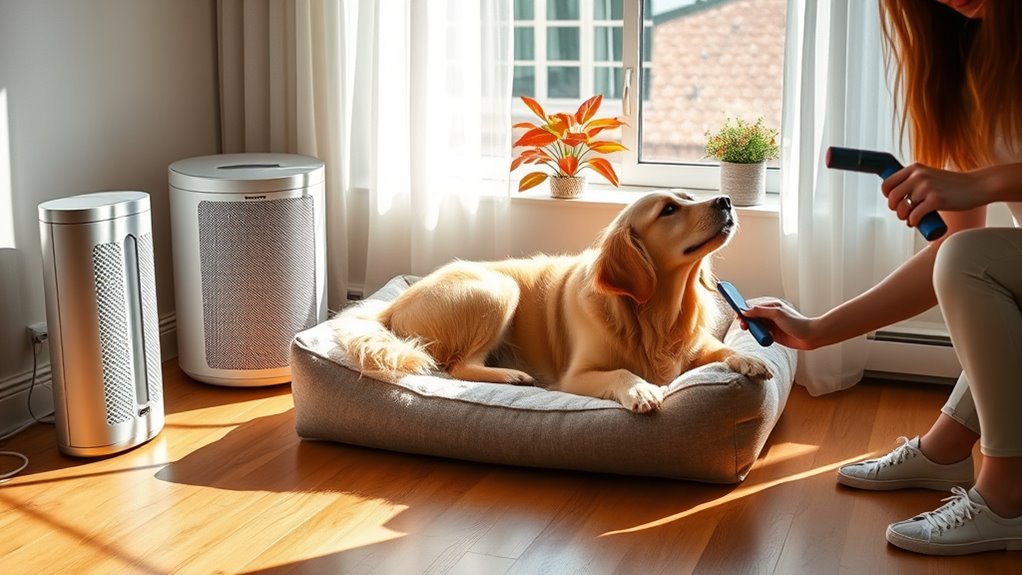If you have pet allergies, there are effective strategies to live happily with your furry friend. Regular grooming reduces allergens, so brush and bathe your pet often. Maintain a clean home by vacuuming with HEPA filters and washing pet bedding frequently. Designate pet-free zones, especially in your bedroom. For relief, use antihistamines or consult a doctor for personalized options. With these tips, you can enjoy your pet more while managing allergies. There’s even more to discover!
Key Takeaways
- Regular grooming, including brushing and bathing, significantly reduces allergens in your home.
- Create pet-free zones, especially in bedrooms, to minimize exposure to allergens.
- Use HEPA filters in vacuums and air purifiers to effectively trap pet dander.
- Consult with a healthcare professional for allergy testing to identify specific triggers.
- Consider medical treatments like antihistamines or allergy shots for long-term relief.

Have you ever wondered why your eyes itch or your nose runs after spending time with your furry friend? It’s a common issue for pet lovers and can stem from pet allergies. These allergies are often triggered by proteins found in the skin, saliva, or urine of animals. If you’re experiencing these symptoms, it’s essential to understand what’s happening and how to manage it while still enjoying the company of your beloved pet.
Pet allergies can cause itchy eyes and a runny nose, but understanding and managing them allows you to enjoy your furry friend.
One effective way to reduce allergy symptoms is through regular pet grooming. When you groom your pet, you’re helping to minimize the amount of dander and loose hair that can scatter throughout your home. Brushing your pet outside can considerably cut down on the allergens that accumulate indoors. You might also consider bathing your pet more frequently, as this can help wash away allergens before they have a chance to cause a reaction. Just make sure to use a pet-friendly shampoo that won’t irritate their skin.
If you suspect you have pet allergies, allergy testing can provide clarity. A healthcare professional can help determine whether your symptoms are indeed related to your pet or caused by something else entirely. Testing usually involves a simple skin prick or blood test that can identify specific allergens. Once you know what triggers your allergies, you can develop a more effective strategy for managing your symptoms.
In addition to grooming and allergy testing, there are other practical steps you can take to create a more allergy-friendly home. Start by keeping your living spaces clean. Regular vacuuming with a HEPA filter can help trap allergens, and washing your pet’s bedding frequently will help reduce dander accumulation. Consider designating certain areas of your home as pet-free zones, particularly your bedroom, to give yourself a safe haven from allergens.
Lastly, speak with your doctor about possible medications or treatments that can help alleviate your symptoms. Some people find relief with antihistamines or nasal sprays, while others may benefit from allergy shots. The key is to find a combination of strategies that works for you. Additionally, incorporating eye patches during allergy flare-ups can help reduce puffiness and irritation around the eyes.
Living with pets while managing allergies can be challenging, but with the right approach, you can enjoy your time with your furry friends and minimize discomfort. Embrace pet grooming, consider allergy testing, and take proactive steps to create a comfortable and healthy environment for both you and your pet.
Frequently Asked Questions
Can I Develop Allergies to My Pet Later in Life?
Yes, you can develop allergies to your pet later in life. As your immune system changes, it might start reacting to allergens in your pet’s dander or saliva. If you suspect you’re experiencing symptoms, consider allergy testing to identify triggers. Regular pet grooming can help reduce dander and minimize reactions. Keeping your pet clean and well-groomed may make a difference in your comfort and overall health while living with your furry friend.
Do Hypoallergenic Pets Exist?
You might be hoping for a miracle when it comes to pets and allergies. The truth? Hypoallergenic pets do exist, but they’re not entirely allergy-proof. Certain breeds, like Poodles and Bichon Frises, produce fewer allergens, challenging some pet allergy myths. However, even these breeds can trigger reactions, depending on your sensitivity. So, if you’re considering one, be prepared to do your research and possibly test your limits before making a commitment.
How Can Diet Affect Pet Allergies?
Diet can considerably affect pet allergies by influencing allergen exposure. When you choose high-quality pet food, it can minimize the risk of allergic reactions in your furry friend. Some ingredients might trigger allergies, so it’s essential to monitor what your pet eats. You might want to contemplate grain-free or limited-ingredient diets to reduce allergen exposure. Always consult with your vet to find the best nutrition plan for your pet’s specific needs.
Are There Specific Breeds Better for Allergy Sufferers?
Yes, some breeds are better for allergy sufferers due to their allergy-friendly traits. When considering breed selection, look for dogs and cats that have hair instead of fur, like Poodles or Bichon Frises. These breeds shed less dander, which can help reduce allergic reactions. Additionally, smaller breeds tend to produce fewer allergens. Always spend time with a breed before bringing one home to see how your allergies react.
Can Pet Allergies Worsen Over Time?
Yes, pet allergies can worsen over time. You might notice your pet allergy symptoms intensifying as you’re exposed to allergens more frequently. This is especially true if you haven’t undergone allergy testing to identify your triggers. Your body can become increasingly sensitive, making it vital to monitor your reactions and adapt accordingly. Staying aware of any changes in your symptoms can help you manage your environment and maintain your comfort around pets.
Conclusion
Living with pets can feel like a constant battle between love and allergies. On one side, there’s the joy of cuddling your furry friend, their playful antics filling your home with laughter. On the other, the sneezes and itchy eyes remind you of your sensitivity. By implementing simple changes—like regular cleaning and designated pet-free zones—you can embrace the warmth of companionship while keeping your health in check. It’s all about finding harmony in the chaos of pet ownership.









